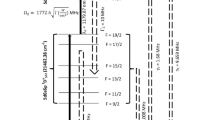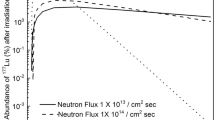Abstract
Many isotopes (stable or radio-active) are widely used for medical therapy, diagnostics, agriculture, food processing and nuclear power generation, to name a few. Isotope separation using lasers constitutes one of the major challenges in research in physics and chemistry. This article traces some of the important initiatives taken at BARC, in India, towards these goals.



Similar content being viewed by others
References
Parthasarathy V, Sarkar SK, Bajaj PN (2008) Laser isotope separation. In: Lackner (ed) Lasers in chemistry. Wiley-VCH Publications, Chap 28, pp 801–838
Sarkar SK, Parthasarathy V (2007) Molecular isotope separation programme at BARC BARC Report BARC/2007/E/014
Mathi P, Nayak AK, Parthasarathy V, Sarkar SK (2006) Laser enrichment of light and middle mass isotopes: prospects and challenges. In: Satoshi Kaneco (ed) Photo/electrochem and photobiology in environment energy and fuel. pp 227–257. ISBN: 81-308-0122-1
Sarkar SK (2005) Laser isotope separation in Isotope enrichment techniques. IANCAS Bull IV(4):285
Manson Benedict M, Pigford TH, Levi HW (1981) Nuclear chemical engineering, 2nd edn. McGraw-Hill Book Company, New York.
Letokhov VS, Moore CB (1977) Laser isotope separation. In: Moore CB (ed) Chemical and biochemical applications of lasers, vol 3. Academic Press, New York
Hargrove S (2000) Lawrence Livermore National Laboratory. Sci Technol Rev 13–21
Rao PR (2003) Laser isotope separation of uranium. Curr Sci 85:5
Sarkar SK, Mittal JP (2002) Breaking bonds to order—a dream still alive. Asian Chem Lett 6:1
Sarkar SK (2000) Free electon laser photochemistry: current developments and future prospects. PINSA 66A:71
Sarkar SK, Mittal JP (1999) Laser selective chemistry. In: Agarwala RP (ed) Laser in materials science. Trans Tech Pub, Switzerland, pp 1–46
Arai S, Ikawa K, Matsumoto Y, Iizuka Y, Sugita K, Sarkar SK, Kuribayashi S (1998) Infrared multiple photon decomposition of CHXF2 (X=Cl or Br) by infrared lasers. Nucl Instr Methods Phys Res B 144:193
Sarkar SK, Mittal JP, Rama Rao KVS, Nath AK, Chatterjee UK (1980) Infrared multiphoton induced chemistry: competitive energy dynamics of excitation and dissociation in SF6. Ind J Phys 54B:311
Mathi P, Joshi DN, Sahoo PK, Deo MN, Nayak AK, Sarkar SK, Parthasarathy V (2008) A novel two stage process for laser enrichment of sulphur isotopes. J Photochem Photobiol A Chem 194:344
Sarkar SK, Karve RS, Rama Rao KVS, Mittal JP (1981) Sensitized multiphoton dissociation of UF6 in SF6–UF6 mixtures by a TEA CO2 laser. Chem Phys Lett 78:273
Sarkar SK (2002) Photochemistry of volatile uranium compounds. Nat Acad Sci Lett 25:258
Sarkar SK, Bajaj PN, Talukdar RK, Parthasarathy V, Rama Rao KVS, Mittal JP, Chakraborti PK (1987) Thermal stability and IR laser driven selective photochemistry of volatile uranyl compound with natural abundance. Chem Phys 113:159
Sarkar SK, Karve RS, Rama Rao KVS, Mittal JP (1991) TEA CO2 laser induced photodissociation of UF6 via inter-species V–V energy transfer from multiphoton excited halomethanes. Appl Phys B 53:108
Sarkar SK, Subbiah J, Rama Rao KVS, Mittal JP (1980) Laser photochemistry of UF6. Ind J Phys 54B:121
Sarkar SK (2005) Competitive energy dynamics in IRMPD of UF6. Ind J Chem 44A:49
Karve RS, Nayak AK, Sarkar SK, Rama Rao KVS, Mittal JP (1989) Highly selective tritium isotope separation in CTF3/HF3 system by multiple frequency multiple photon dissociation. Appl Phys B 49:571
Nayak AK, Sarkar SK, Biswas DJ, Rama Rao KVS, Mittal JP (1991) Separation of tritium from deuterium by pulsed NH3 laser selective multiple photon dissociation of CTCl3. Appl Phys B 53:246
Sarkar SK, Rama Rao KVS, Mittal JP (1989) T/D isotope selectivity in CO2 laser induced multiple frequency multiphoton dissociation of trifluoromethane-T. Appl Phys B 49:139
Sarkar SK, Parthasarathy V, Shikharkhane NS, Chatterjee UK, Nundy U, Rama Rao KVS, Mittal JP, Bhawalkar DD, Puretzky AA (1986) IRMPD of CDF3 in two frequency IR fields. Laser Chem 6:85
Parthasarathy V, Sarkar SK, Iyer NV, Rama Rao KVS, Mittal JP (1993) Laser isotope separation of carbon-13: a comparative study. Appl Phys B 56:321
Mathi P, Nayak AK, Parthasarathy V, Sarkar SK, Abhinanadan L, Bhatnagar R (2005) Laser enrichment of carbon-13: operational experience with a large photochemical reactor for macroscopic separation. J Photochem Photobiol A Chem 169:29
Mathi P, Nayak AK, Parthasarathy V, Sarkar SK (2005) On scaling up of carbon isotopes’ enrichment by infrared laser chemistry of CF2HCl. J Photochem Photobiol A Chem 169:187
Sarkar SK, Nayak AK, Parthasarathy V, Rama Rao KVS, Mittal JP (1992) IRMPD in focused laser beams: I. Generalisation. Infrared Phys 33:493
Sarkar SK, Nayak AK, Parthasarathy V, Rama Rao KVS, Mittal JP (1992) IRMPD in focused laser beams: II. Application to T/D/H separation. Infrared Phys 33:505
Parthasarathy V, Nayak AK, Sarkar SK (2002) Control strategies for laser separation of carbon isotopes. Proc Ind Acad Sci 116:1
Acknowledgments
The authors gratefully acknowledge the support of their LIS colleagues in Laser and Plasma Technology Division and Radiation and Photochemistry Division, BARC. In addition, they would like to put on record special thanks to BARC for continuing support for this activity. SKS would like to thank the DAE for the award of the Raja Ramanna fellowship.
Author information
Authors and Affiliations
Corresponding author
Rights and permissions
About this article
Cite this article
Mathi, P., Parthasarathy, V., Nayak, A.K. et al. Laser Isotope Separation: Science and Technology. Proc. Natl. Acad. Sci., India, Sect. A Phys. Sci. (2015). https://doi.org/10.1007/s40010-015-0249-6
Received:
Accepted:
Published:
DOI: https://doi.org/10.1007/s40010-015-0249-6




